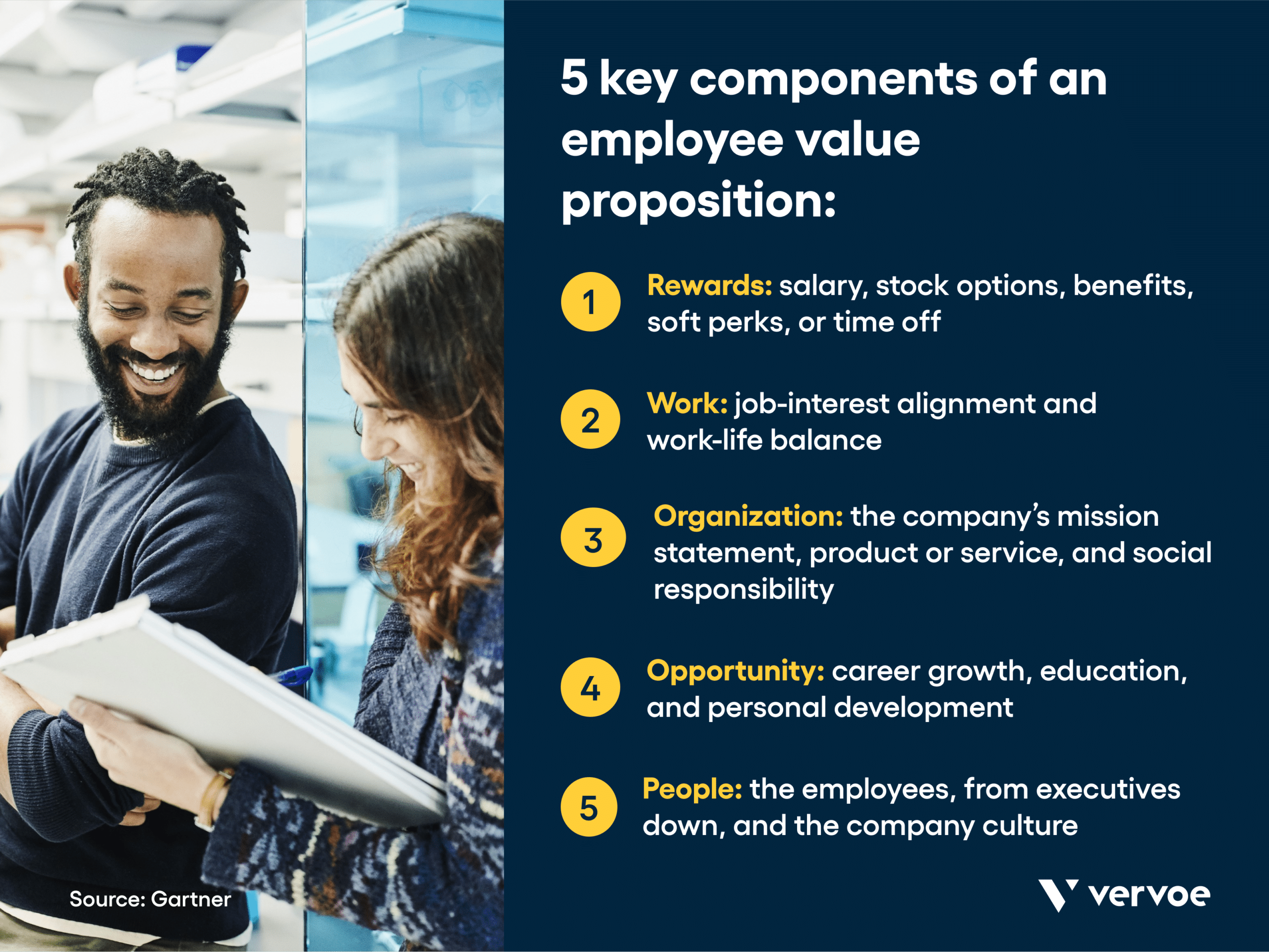As employee expectations change, many employers trying to create employee value propositions (EVP) for the first time. Millennials and Gen Z workers expect their work to mean something, and for their employer to support them beyond a paycheck.
The pandemic has also changed the way employees think about their work. Gartner’s research found that “only 31% of HR leaders think their employees are satisfied with their EVP, and 65% of candidates report they have actually discontinued a hiring process due to an unattractive EVP”.
This re-calculation has many organizations starting fresh. If don’t have experience developing an employee value proposition, or are seeking to update your EVP, this guide offers everything you need to get started.
Why is an employee value proposition important?
Research shows that organizations with strong employee value propositions can improve employee retention, recruit top talent better, and build higher returns.
Research from Gartner finds companies that deliver on their EVP are able to decrease annual employee turnover by just under 70% and increase new hire commitment by nearly 30%. A strong EVP can drive higher engagement and motivation among employees, which in turn furthers business results.

Engaged teams are found to have:
- 21% greater profitability
- 17% higher productivity
- 10% higher customer ratings than disengaged teams
The best employee value propositions also help build the inclusive work environment needed to attract and foster diverse talent. It’s well documented that diverse companies outperform their homogenous peers in metrics like innovation, profit, and customer satisfaction. An EVP that combines thoughtful benefits with fair and equal compensation is likely to help a company grow margins across the board.
An EVP also plays a role in recruiting. Companies that are able to articulate the benefits of joining their workforce are better able to attract talent.
“According to our research, across every demographic, an attractive salary and benefits are the most important attribute that motivates workers to choose an employer, and it is also the second most important trait that keeps them in place (job security is ranked first, but it is ahead by only a minuscule amount),” according to Ranstad.
There’s a common misconception that a strong EVP must consist of expensive perks and benefits. In reality, an EVP can actually save money for an organization. The right combination of inclusive company culture, professional opportunities, benefits, compensation, and rewards can not only reduce recruiting costs but also lower the compensation premium by 50%.
How can you find that perfect combination of rewards, benefits, and non-monetary perks to help you capture the benefits of a strong EVP? It starts with understanding the different components of an employee value proposition.
What are the components of an employee value proposition?
An employee value proposition is more than just a marketing exercise. These campaigns go beyond compensation to understand what employees need to be successful at work each and every day.
In the past, Gartner’s research identified five key components that frame an employee value proposition:
- Rewards: salary, stock options, benefits, soft perks, or time off
- Work: job-interest alignment and work-life balance
- Organization: the company’s mission statement, product or service, and social responsibility
- Opportunity: career growth, education, and personal development
- People: the employees, from executives down, and the company culture
The pandemic has shifted these components slightly. “The EVP for the post-pandemic workforce must orient toward employees as people, not workers; provide an exceptional life, not work, experience; and focus on the feelings, not just the features that match employee needs,” Gartner writes.

The new components of an employee value proposition are:
- Deeper connections: Organizations should make employees feel understood by strengthening their connections to family and community, not just work relationships.
- Radical flexibility: Employees seek to feel autonomous in their work; organizations must provide flexibility on aspects beyond the “when” and “where” of work.
- Personal growth: Employees want to feel valued; they look to the organization to help them grow as people, not just as professionals.
- Holistic well-being: Organizations should find ways to reinforce that employees are cared for through holistic well-being offerings, such as mental health counseling.
- Shared purpose: Companies with strong EVPs ensure individuals are invested in the organization, championing meaningful action by the organization on societal and cultural issues.
These human-centered components are still rooted intangible benefits. For instance, in the US, health benefits and location are the second and third-highest ranked factors for employees considering a new job. Perks like paid family leave, free fitness memberships, and student loan repayments are all rewards that further things like holistic well-being and radical flexibility. The best employee value propositions build the inclusive work environment needed to attract and foster diverse talent.
5 Steps to creating a compelling employee value proposition
Creating a compelling employee value proposition is more than just a marketing exercise. Follow these steps to get started creating an EVP that helps your company grow.
Collect feedback from current employees
The first step in creating an employee value proposition is to understand what it is that employees enjoy about their work experience. Spend time surveying employees to learn what they value in your company’s culture, benefits, and perks.
One way to do this is through an anonymous survey. Keeping it anonymous allows employees to speak freely. Ask for detailed answers to questions such as,
- What first attracted you to this company?
- Have your expectations lived up to the reality of working here?
- What tangible benefits do we offer that you most value?
- What intangible benefits do we offer that you most value?
- What do you find fulfilling (and challenging) about working here?
- What do you appreciate most (and least) about working here?
Be open to criticism as well as praise as in this stage, all information is good information. You may identify areas for improvement, or learn that what you thought employees valued isn’t actually garnering much appreciation. This feedback may be tough to swallow, but it does also allow you to reallocate investment to what is working.
Exit interviews are another good way of finding out what’s working, and what’s not. Speak to employees who are leaving for a new opportunity to find out what they valued most about their time at your company.
Align your offering with your talent goals
The primary audience for your EVP isn’t just your current employees – it’s your future hires, too. As a result, you need to consider what your hiring goals are for the next few years and align your EVP accordingly.
What does this mean in practice? You may need to adjust your compensation or perks to reflect the roles you plan to hire for in the coming months. For instance, if you plan to hire web developers, you may wish to offer an internet allowance, flexible remote work, and advanced certification opportunities. If you know you will need more entry-level employees, customize your EVP to include student loan repayment, a fun office environment, and volunteering opportunities.
Define your EVP
Once you know what you already offer, and have a sense of what you might need to offer in the future, it’s time to nail down your employee value proposition. Define your employee value proposition by answering these questions:
- What are your business needs? Refer to your talent strategy and determine the new hires you will hope to attract and motivate with your EVP.
- What do you expect from your employees? Your EVP should clarify and unite employees behind what you expect of them to achieve the business’s mission. Align your expectations with what you stand for as a company, and make sure your compensation is set up to help employees be successful in reaching these expectations.
- What do employees and candidates want in an employer? Make sure the package you offer is relevant. For instance, offering parental leave may not be enticing to recent college grads. Consider the insights from your employees and the results of your exit interviews.
- What makes your EVP unique? Find a way to articulate how your offering is unlike your competitors. Keeping the human components of your EVP – like shared purpose, personal growth, and flexibility – at the forefront will help you design an EVP that’s completely original.
Answering these questions will help you craft an EVP statement that is clear and inspirational. The statement is just a starting point, however.
Create a narrative
Once you’ve developed an EVP, build a narrative around it to help bring it to life. Note that an EVP is not the same as an employer value proposition or employer brand. But there needs to be some consistency between them.
“We describe an employer brand as how you tell a cohesive, consistent story about what you stand for as an employer (your EVP) to candidates and employees. It’s how you express your EVP—in words, visuals, style, and tone,” wrote the experts at Aon.
There are numerous ways to convey your EVP. Many top companies include a page on their careers site that outlines the perks, compensation, and benefits that come with the job. Others use video testimonials from existing workers to share their employee experiences and provide insight into life at the company. LinkedIn has its own branded hashtag, #LifeAtLinkedIn, to encourage employees to post spontaneously about their work.
Don’t be afraid to have a little fun with your EVP. Nike’s EVP uses consistent branding from the retailer’s other marketing campaigns, lending an aspirational feel to its team-oriented company culture. And, Netflix, as you’d expect, uses videos to share more about its company culture and commitment to diversity. To be effective, your EVP should feel authentic and unique to your brand — and be backed up by real benefits and a culture your employees love.
Evolve over time
Companies are constantly changing, and as your employees retire or move on to their next opportunity, you may need to revisit your EVP. Regularly check to confirm that your employee value proposition still reflects reality for your workforce and that it aligns with your company’s mission and goals.
Likewise, build a feedback loop into your employee review to continue iterating on your EVP. Exit interviews, performance reviews, and onboarding questionnaires are all great opportunities to measure expectations and adjust your benefits accordingly. As things change, update your EVP should change too.
For more hiring advice and resources, sign up for Vervoe’s newsletter.






















